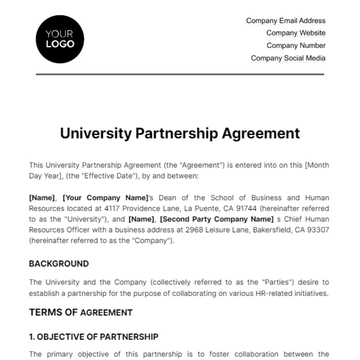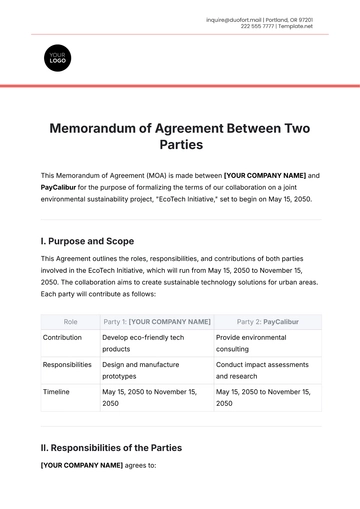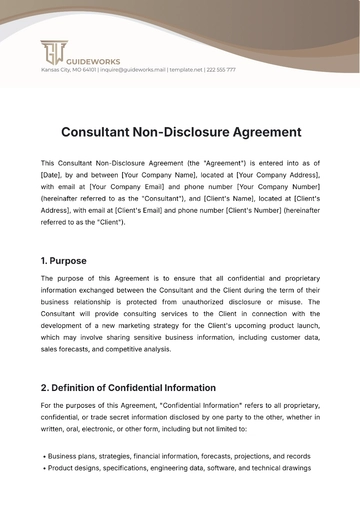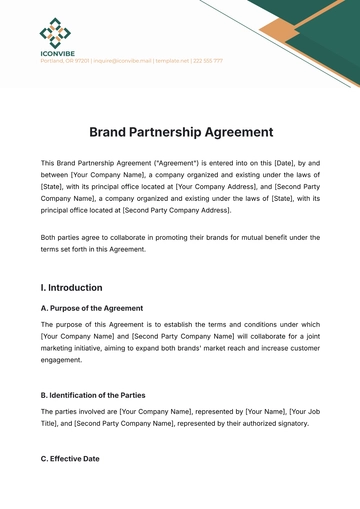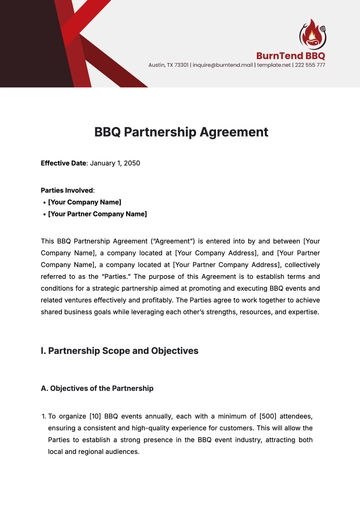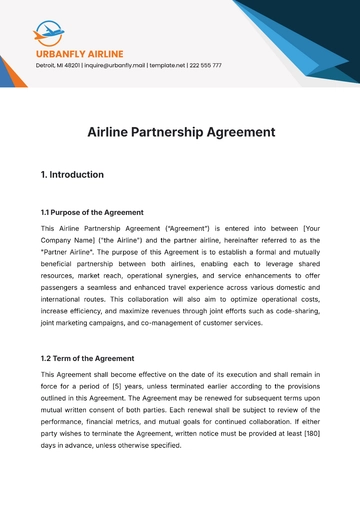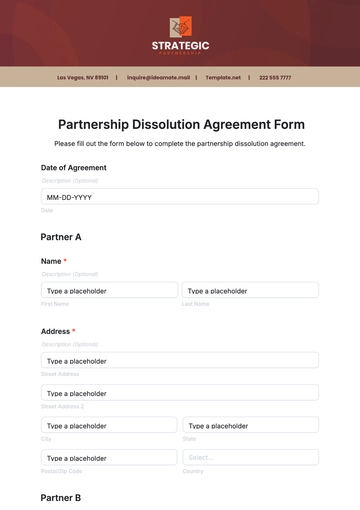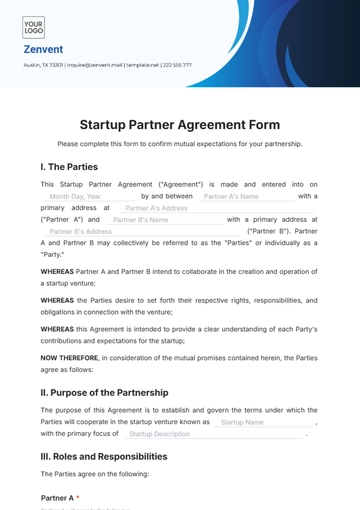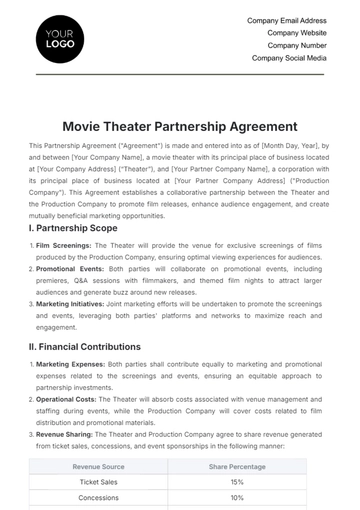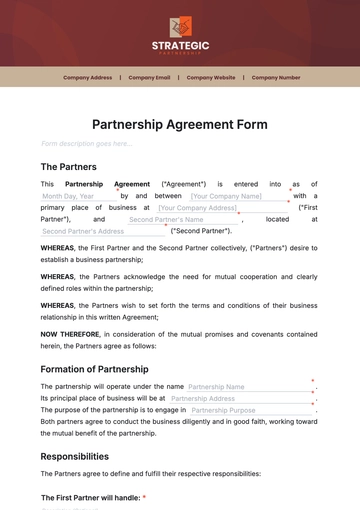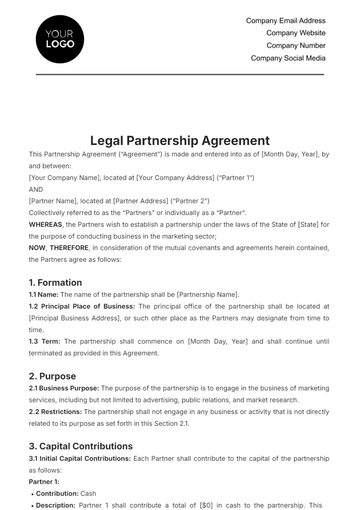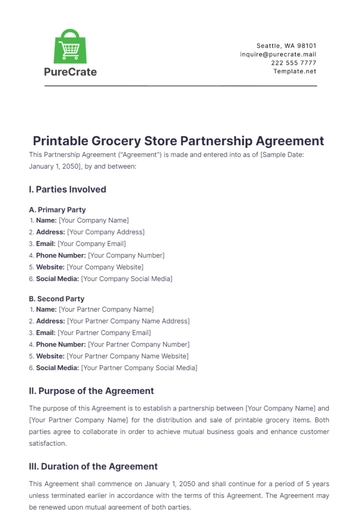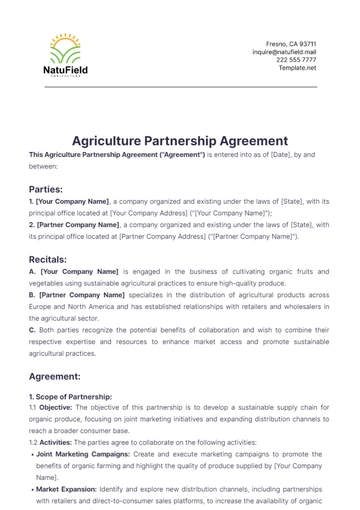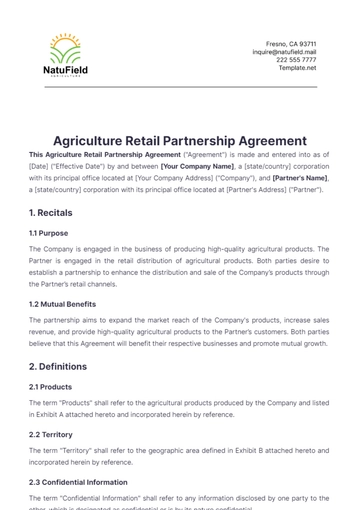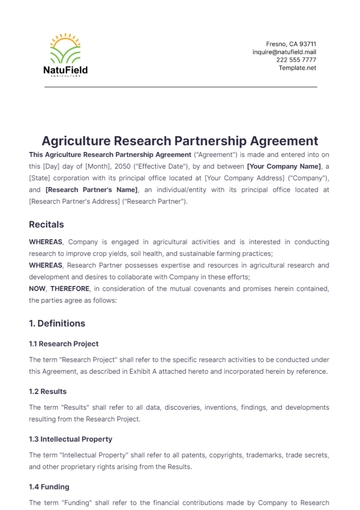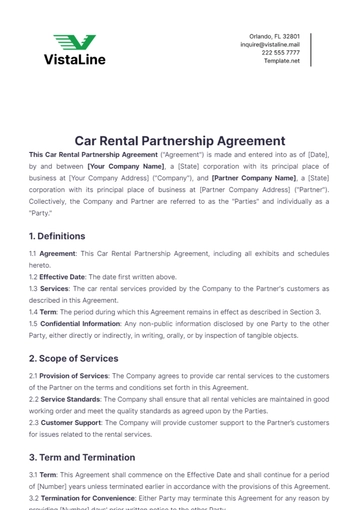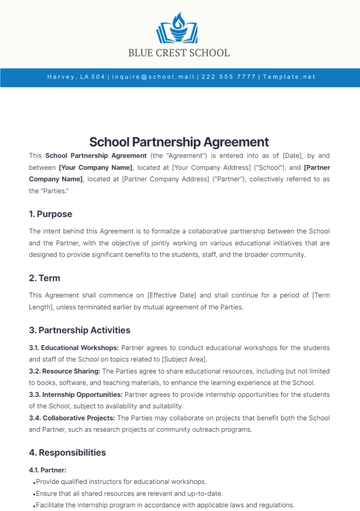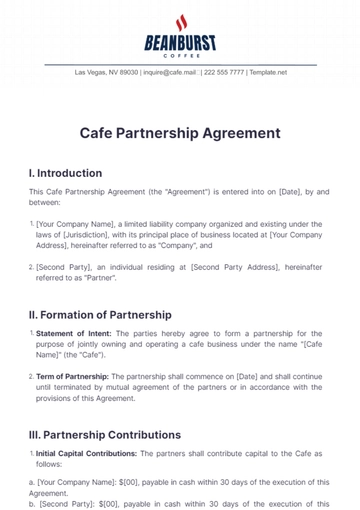Free Blank Bakery Partnership Agreement
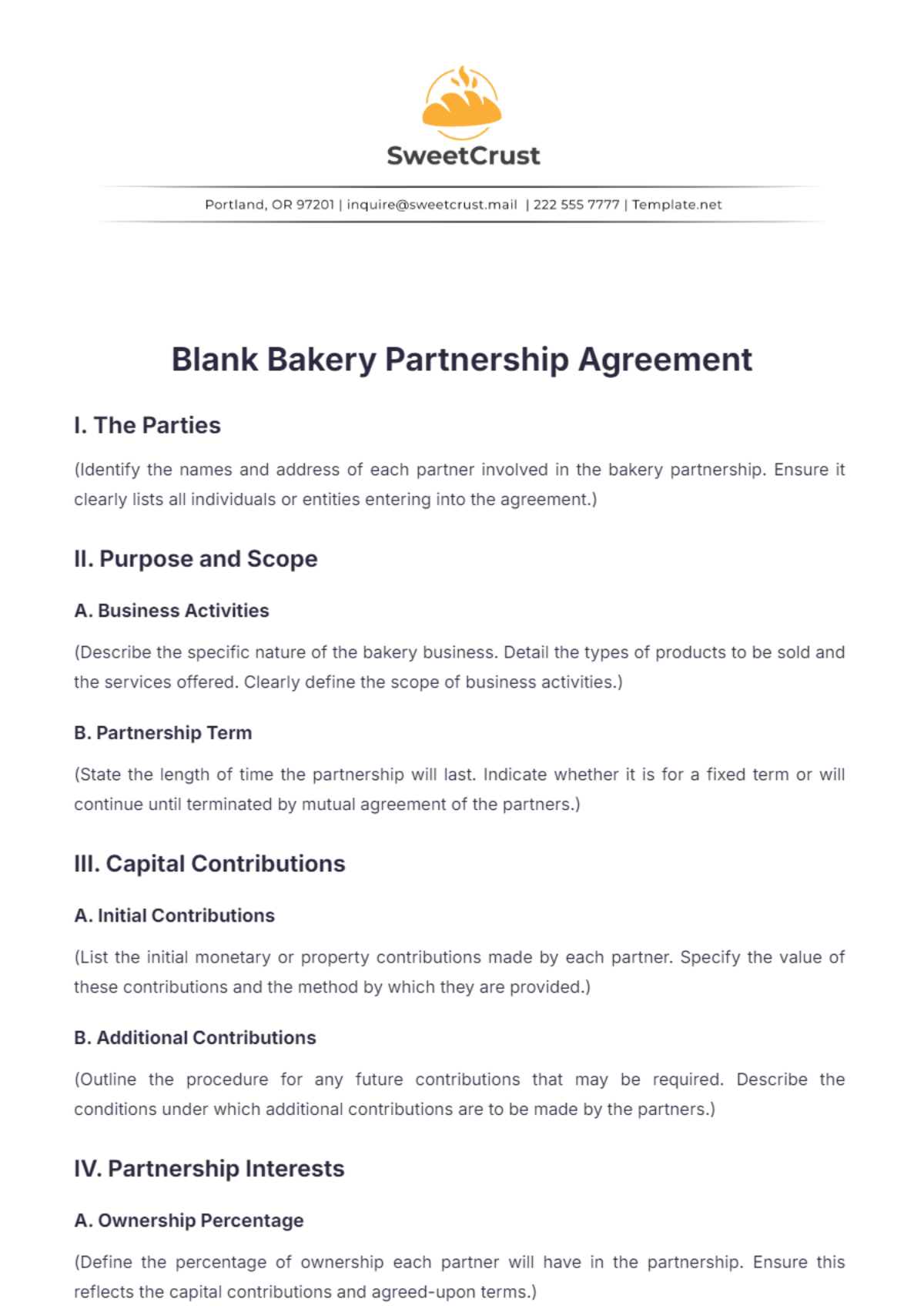
I. The Parties
(Identify the names and address of each partner involved in the bakery partnership. Ensure it clearly lists all individuals or entities entering into the agreement.)
II. Purpose and Scope
A. Business Activities
(Describe the specific nature of the bakery business. Detail the types of products to be sold and the services offered. Clearly define the scope of business activities.)
B. Partnership Term
(State the length of time the partnership will last. Indicate whether it is for a fixed term or will continue until terminated by mutual agreement of the partners.)
III. Capital Contributions
A. Initial Contributions
(List the initial monetary or property contributions made by each partner. Specify the value of these contributions and the method by which they are provided.)
B. Additional Contributions
(Outline the procedure for any future contributions that may be required. Describe the conditions under which additional contributions are to be made by the partners.)
IV. Partnership Interests
A. Ownership Percentage
(Define the percentage of ownership each partner will have in the partnership. Ensure this reflects the capital contributions and agreed-upon terms.)
B. Transfer of Interests
(Detail the process for transferring partnership interests. Specify any restrictions or conditions that apply to the transfer to ensure all partners agree.)
V. Profit and Loss Allocation
A. Profit Distribution
(Describe how profits will be distributed among the partners. Indicate the percentage or method of allocation based on ownership interests or another agreed-upon formula.)
B. Loss Sharing
(Explain the mechanism for sharing any losses incurred by the business. Detail whether losses will be allocated in the same proportion as profits.)
VI. Partnership Management
A. Decision Making
(Outline the decision-making process within the partnership. Include whether decisions require a majority vote, unanimous consent, or follow another method.)
B. Roles and Responsibilities
(Specify the roles and responsibilities of each partner in the day-to-day operations. List duties, authority limits, and any designated titles or positions.)
C. Meetings
(Set the schedule and procedure for regular partnership meetings. Describe how often meetings will occur, who will attend, and how the meeting agenda will be set.)
VII. Accounting and Records
A. Financial Records
(Detail the type of financial records that will be maintained. Ensure procedures for bookkeeping and accounting are included and defined.)
B. Partner Access
(State that all partners have access to the financial records. Specify the process for reviewing and inspecting these records by partners.)
VIII. Dispute Resolution
A. Mediation
(Describe the mediation process in the event of a dispute between partners. Include steps and conditions for initiating mediation.)
B. Arbitration
(Provide details for arbitration if mediation fails. Specify the arbitration process and how the arbitrators will be selected and the rules to be followed.)
IX. Withdrawal or Death of a Partner
A. Voluntary Withdrawal
(State the conditions under which a partner may voluntarily withdraw. Detail the notice required and the financial settlement process.)
B. Death or Incapacity
(Explain the procedure upon the death or incapacity of a partner. Include terms for the transfer of partnership interests to heirs or buyout options.)
X. Dissolution of Partnership
A. Events Triggering Dissolution
(List the events that will trigger the dissolution of the partnership. Detail specific scenarios such as mutual consent, bankruptcy, or legal requirements.)
B. Winding Up
(Specify the process for winding up the partnership affairs. Include steps to be taken for liquidating assets, settling liabilities, and distributing remaining assets to partners.)
XI. Amendments
A. Procedure
(Describe the procedure for amending the partnership agreement. State the required approval process and how amendments will be documented.)
B. Notification
(Detail how partners will notify each other of proposed amendments. Include the time frame for consideration and implementation of any changes.)
XII. Signatures
(Provide space for the signatures of all partners involved. Include the date and a statement acknowledging that all parties agree to the terms of the agreement.)
- 100% Customizable, free editor
- Access 1 Million+ Templates, photo’s & graphics
- Download or share as a template
- Click and replace photos, graphics, text, backgrounds
- Resize, crop, AI write & more
- Access advanced editor
Facilitate seamless collaborations with the Blank Bakery Partnership Agreement Template! Available on Template.net, this editable and customizable template allows you to tailor partnership terms to fit your bakery's specific needs. Use the advanced AI Editor Tool to ensure clarity and precision, helping you establish strong, mutually beneficial partnerships with ease!
You may also like
- Lease Agreement
- Non Compete Agreement
- Rental Agreement
- Prenuptial Agreement
- Non Disclosure Agreement
- Operating Agreement
- Hold Harmless Agreement
- LLC Operating Agreement
- Arbitration Agreement
- Purchase Agreement
- Residential Lease Agreement
- Executive Agreement
- Confidentiality Agreement
- Contractor Agreement
- Partnership Agreement
- Postnuptial Agreement
- Collective Bargaining Agreement
- Loan Agreement
- Roommate Agreement
- Commercial Lease Agreement
- Separation Agreement
- Cohabitation Agreement
- Room Rental Agreement
- Child Custody Agreement
- Employee Agreement
- License Agreements
- Settlement Agreement
- Joint Venture Agreement
- Indemnity Agreement
- Subordination Agreement
- Sales Agreement
- Agreements Between Two Parties
- Business Agreement
- Real Estate Agreement
- HR Agreement
- Service Agreement
- Property Agreement
- Agreement Letter
- Restaurant Agreement
- Construction Agreement
- Finance Agreement
- Marketing Agreement
- Payment Agreement
- Investment Agreement
- Management Agreement
- Nonprofit Agreement
- Software Agreement
- Startup Agreement
- Agency Agreement
- Copyright Agreement
- Collaboration Agreement
- Reseller Agreement
- Car Rental Agreement
- Cleaning Services Agreement
- Consultant Agreement
- Deed Agreement
- Car Agreement
- Equipment Agreement
- Shares Agreement
- Data Sharing Agreement
- Advertising Agreement
- School Agreement
- Franchise Agreement
- Event Agreement
- Travel Agency Agreement
- Vehicle Agreement
- Board Resolution Agreement
- Land Agreement
- Binding Agreement
- Tenancy Agreement
- Exclusive Agreement
- Development Agreement
- Assignment Agreement
- Design Agreement
- Equity Agreement
- Mortgage Agreement
- Purchase and Sale Agreement
- Shareholder Agreement
- Vendor Agreement
- Royalty Agreement
- Vehicle Lease Agreement
- Hotel Agreement
- Tenant Agreement
- Artist Agreement
- Commission Agreement
- Consignment Agreement
- Debt Agreement
- Recruitment Agreement
- Training Agreement
- Transfer Agreement
- Apprenticeship Agreement
- IT and Software Agreement
- Referral Agreement
- Resolution Agreement
- Waiver Agreement
- Consent Agreement
- Partner Agreement
- Social Media Agreement
- Customer Agreement
- Credit Agreement
- Supply Agreement
- Agent Agreement
- Brand Agreement
- Law Firm Agreement
- Maintenance Agreement
- Mutual Agreement
- Retail Agreement
- Deposit Agreement
- Land Purchase Agreement
- Nursing Home Agreement
- Supplier Agreement
- Buy Sell Agreement
- Child Support Agreement
- Landlord Agreement
- Payment Plan Agreement
- Release Agreement
- Research Agreement
- Sponsorship Agreement
- Buyout Agreement
- Equipment Rental Agreement
- Farm Agreement
- Manufacturing Agreement
- Strategic Agreement
- Termination of Lease Agreement
- Compliance Agreement
- Family Agreement
- Interior Design Agreement
- Ownership Agreement
- Residential Lease Agreement
- Retainer Agreement
- Trade Agreement
- University Agreement
- Broker Agreement
- Dissolution Agreement
- Funding Agreement
- Hosting Agreement
- Investor Agreement
- Memorandum of Agreement
- Advisory Agreement
- Affiliate Agreement
- Freelancer Agreement
- Grant Agreement
- Master Service Agreement
- Parking Agreement
- Subscription Agreement
- Trust Agreement
- Cancellation Agreement
- Horse Agreement
- Influencer Agreement
- Membership Agreement
- Vacation Rental Agreement
- Wholesale Agreement
- Author Agreement
- Distributor Agreement
- Exchange Agreement
- Food Agreement
- Guarantee Agreement
- Installment Agreement
- Internship Agreement
- Music Agreement
- Severance Agreement
- Software Development Agreement
- Storage Agreement
- Facility Agreement
- Intercompany Agreement
- Lending Agreement
- Lodger Agreement
- Outsourcing Services Agreement
- Usage Agreement
- Assurance Agreement
- Photography Agreement
- Profit Sharing Agreement
- Relationship Agreement
- Rent To Own Agreement
- Repayment Agreement
- Volunteer Agreement
- Co Parenting Agreement
- HVAC Agreement
- Lawn Care Agreement
- SAAS Agreement
- Work from Home Agreement
- Coaching Agreement
- Protection Agreement
- Security Agreement
- Repair Agreement
- Agreements License
